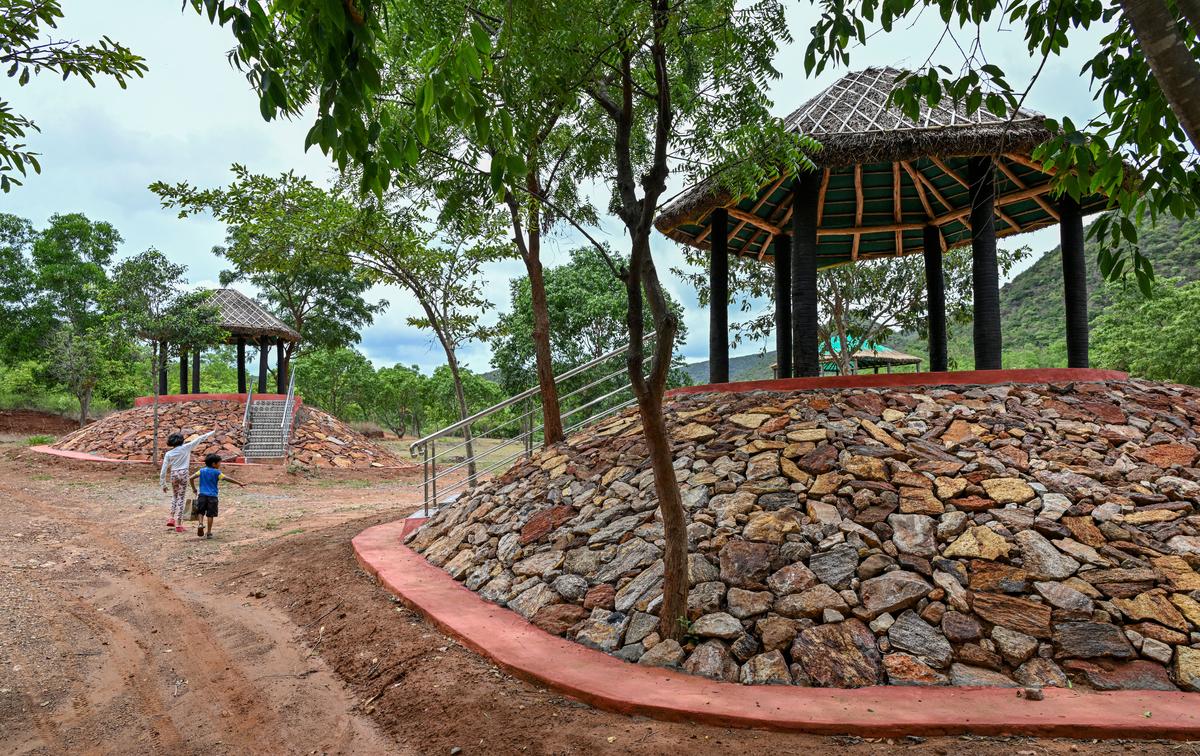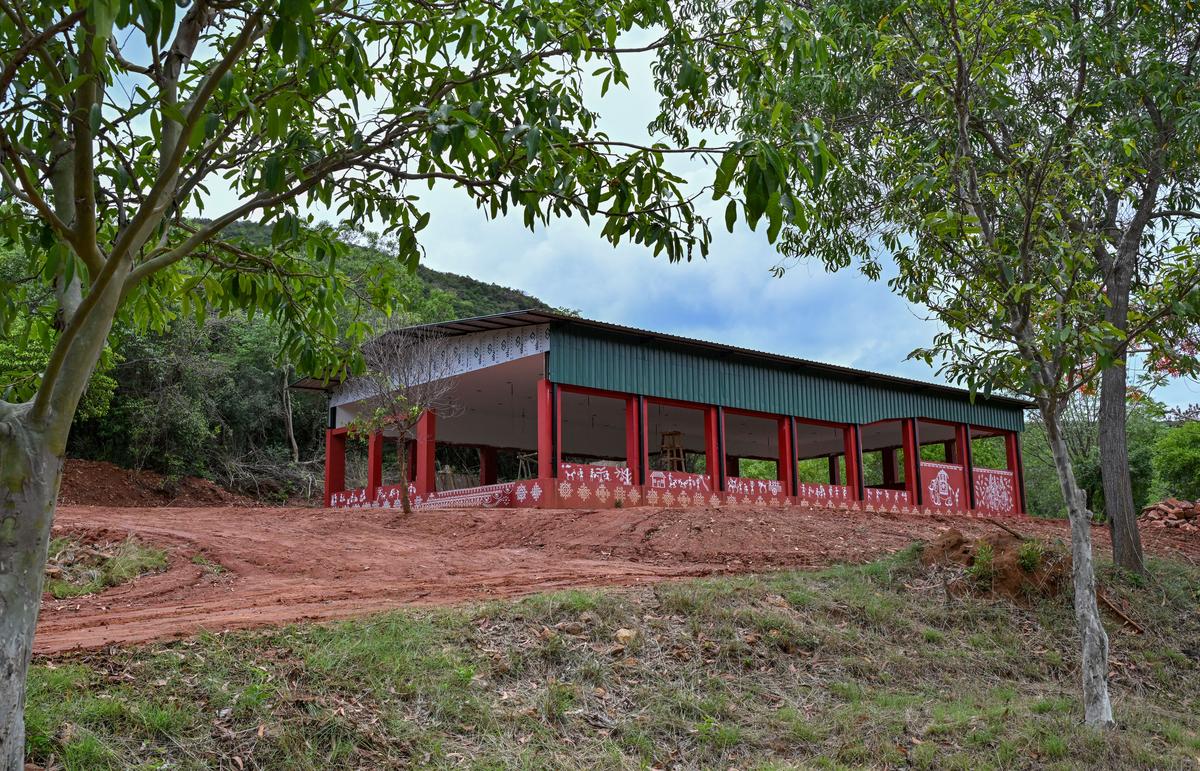As you enter the arched gate of the Kambalakonda Eco-Tourism Park, a soothing symphony of cicadas and birds replaces the din of the city. A trail meanders under a leafy canopy, where the scent of damp earth lingers after the morning spell of pre-monsoon showers. The park opens up gradually, revealing a stretch of meadows flanked by dense tropical deciduous forest, interspersed with scrubland and rocky outcrops. A family of spotted deer grazes just off the path, calm and unafraid, accustomed to sharing this space with visitors. The majestic white-bellied sea eagle glides in slow, purposeful circles above the green expanse, often sighted in the early hours near the waterbody.
Spread across 71 square kilometres, Kambalakonda Wildlife Sanctuary is one of Visakhapatnam’s richest natural treasures. Bordered by the Simhachalam hill range to the west and the Gambheeram reservoir to the north-east, it offers a unique ecological blend with an oasis of mixed forest canopy, scrubland, and perennial water-body, supporting a dense and diverse web of life. Now, thanks to a series of revitalisation initiatives by the Andhra Pradesh Forest Department, the sanctuary and its eco-tourism park are abuzz with new features and upgrades.
A herd of spotted deer rest under the green canopy of Kambalakonda Eco-Tourism Park in Visakhapatnam.
| Photo Credit:
KR Deepak
Under the Nagar Van Yojana (NVY), a Central Government scheme that aims to develop 400 urban forests and 200 vatikas by 2025, Kambalakonda is being transformed not just as a tourist spot but as a vital urban green lung. Managed by the Eco Development Committee of Sambhuvanipalem village, the sanctuary exemplifies community-led conservation.
“We’re developing Kambalakonda as a model eco-tourism destination,” says G Mangamma, Deputy Conservator of Forest and curator of Indira Gandhi Zoological Park. “Of the five cottages being constructed, three are already completed. The remaining two will be ready within two weeks, and we will open them shortly to the public.”
These rustic cottages, tucked into the forest’s edge, are being created to offer an experience rooted in sustainability, allowing visitors to immerse themselves in the sounds and sights of the wild. The project is part of a broader Detailed Project Report (DPR) worth ₹2 crore, of which ₹1.4 crore was sanctioned and ₹75 lakh worth of work completed in the previous year. The rest of the facilities are expected to be ready within the next one month.
A biodiversity hotspot
The sanctuary is home to over 120 species of birds, making it a birder’s paradise. Regular sightings include those of bulbuls, barbets, cuckoos, hornbills, flycatchers, leafbirds and starlings. Along its streams and water-bodies, you might spot white-breasted waterhens, moorhens, herons, lapwings and teals. Species with high conservation priority like the painted stork and the elusive pale-capped pigeon have also been recorded here.
The forest also harbours several mammalian species and reptiles. In a ground-breaking discovery two years ago, the sanctuary recorded the first-ever sighting of the Barkudia limbless skink (Barkudia melanosticta), a small, elusive reptile known for its limbless body and subterranean lifestyle. The sighting thrilled herpetologists and opened new research avenues into the rich, understudied fauna of the Eastern Ghats.
Green infrastructure

Visitors enjoying the view of Kambalakonda from the newly-added watchtower within the eco-tourism park in Visakhapatnam.
| Photo Credit:
KR Deepak
Apart from the new cottages, several other facilities are being built and upgraded to enrich the visitor experience. Three trek routes, popular with locals and tourists alike, are being refurbished ahead of the monsoon, with pathways cleared and signages updated. A block plantation featuring indigenous forest species was raised, creating a mini forest within the sanctuary.
One of the highlights is the amphitheatre, now sporting forest-themed green hues, offering a natural setting for school programmes, community workshops, and Nature-based storytelling events. Nearby, a new yoga and meditation centre invites visitors to engage with Nature through stillness and mindfulness.

Yoga and meditation centre coming up in Kambalakonda Eco Tourism Park in Visakhapatnam.
| Photo Credit:
KR Deepak
Additionally, an interpretation centre is coming up within the eco-tourism park. Designed to educate the public on the sanctuary’s flora and fauna, it will feature informative boards and illustrations. To improve connectivity within the park, a gabion bridge has been constructed linking the eco-tourism zone to Vana Mitra, the Forest Department’s nursery. “Visitors can now directly access the nursery and choose from nearly two lakh plant saplings available,” says Mangamma. The idea is to make conservation tangible, something visitors can take home in the form of a plant.
For the adventurous

People enjoying at the adventure zone in Kambalakonda Eco Tourism Park in Visakhapatnam.
| Photo Credit:
KR Deepak
Adventure and family-friendly recreation have found a place in Kambalakonda’s evolving identity. The Livein Adventures team offers activities like rappelling, slack-lining, ziplining, tyre walks and rope challenges, all integrated into the forest environment. Kayaking adds another dimension of fun here. The revamped children’s play area has been drawing family crowds, while the renovated canteen offers a refreshed menu and resting spot for the weary trekkers.

A view of the watch tower at Kambalakonda Eco Tourism Park in Visakhapatnam.
| Photo Credit:
KR Deepak
Three watchtowers with stone-packed natural stairs and reinforced with wooden sticks have been constructed, offering panoramic views of the sanctuary and beyond. These viewing points, especially at sunrise or sunset, are where Nature puts on a spectacle of light, sound and silence.
Soon, guided nature walks are expected to become a regular feature. At present, they are held sporadically, but as visitor numbers grow and infrastructure scales up, more structured experiences will take shape.
Published – May 24, 2025 09:19 pm IST